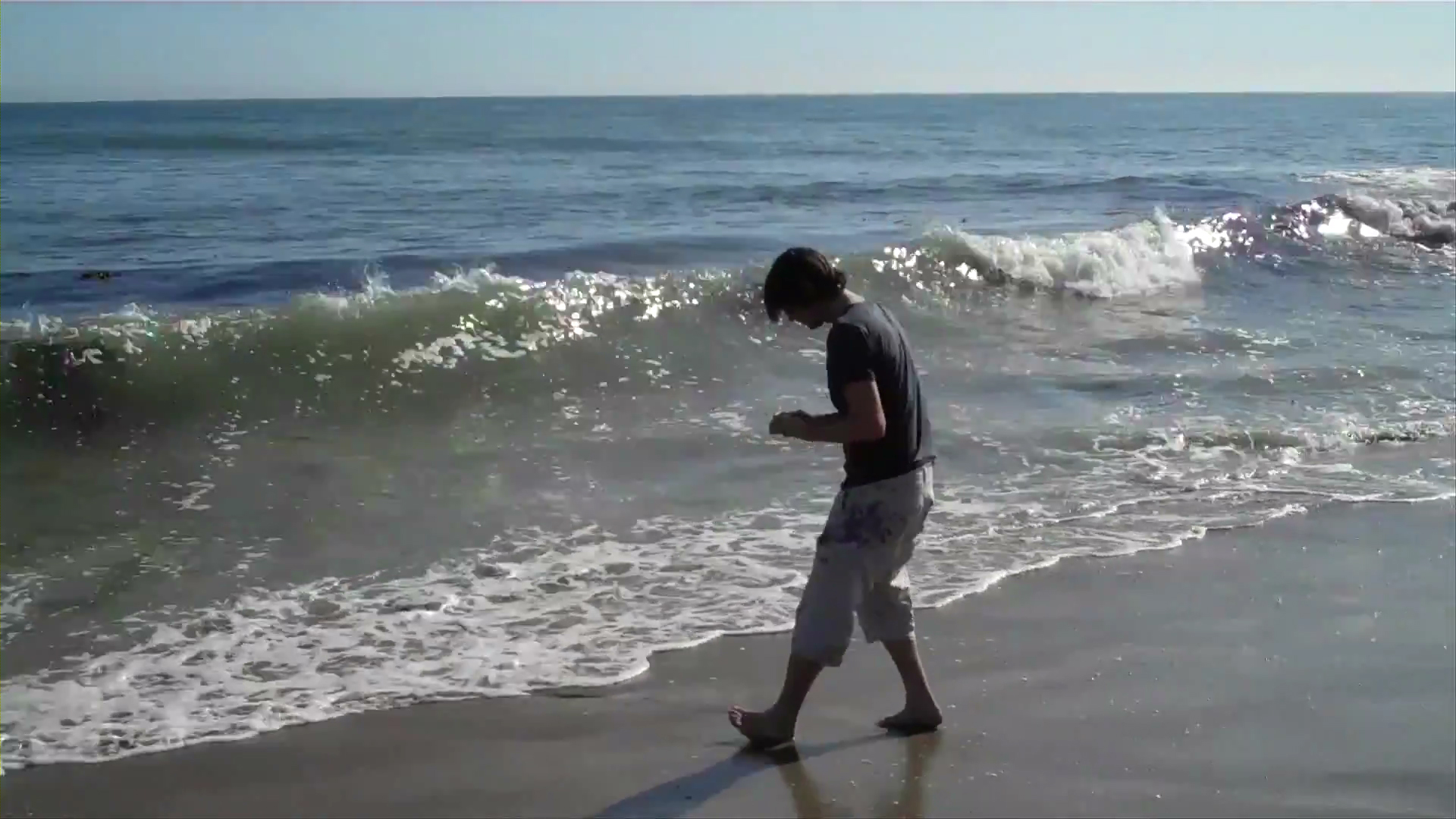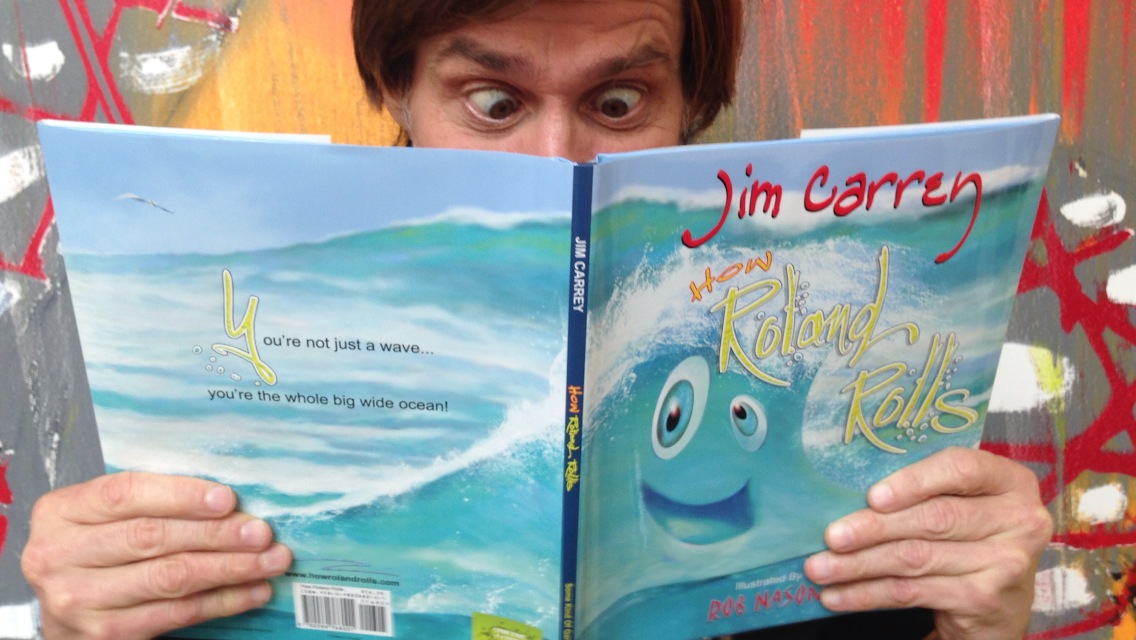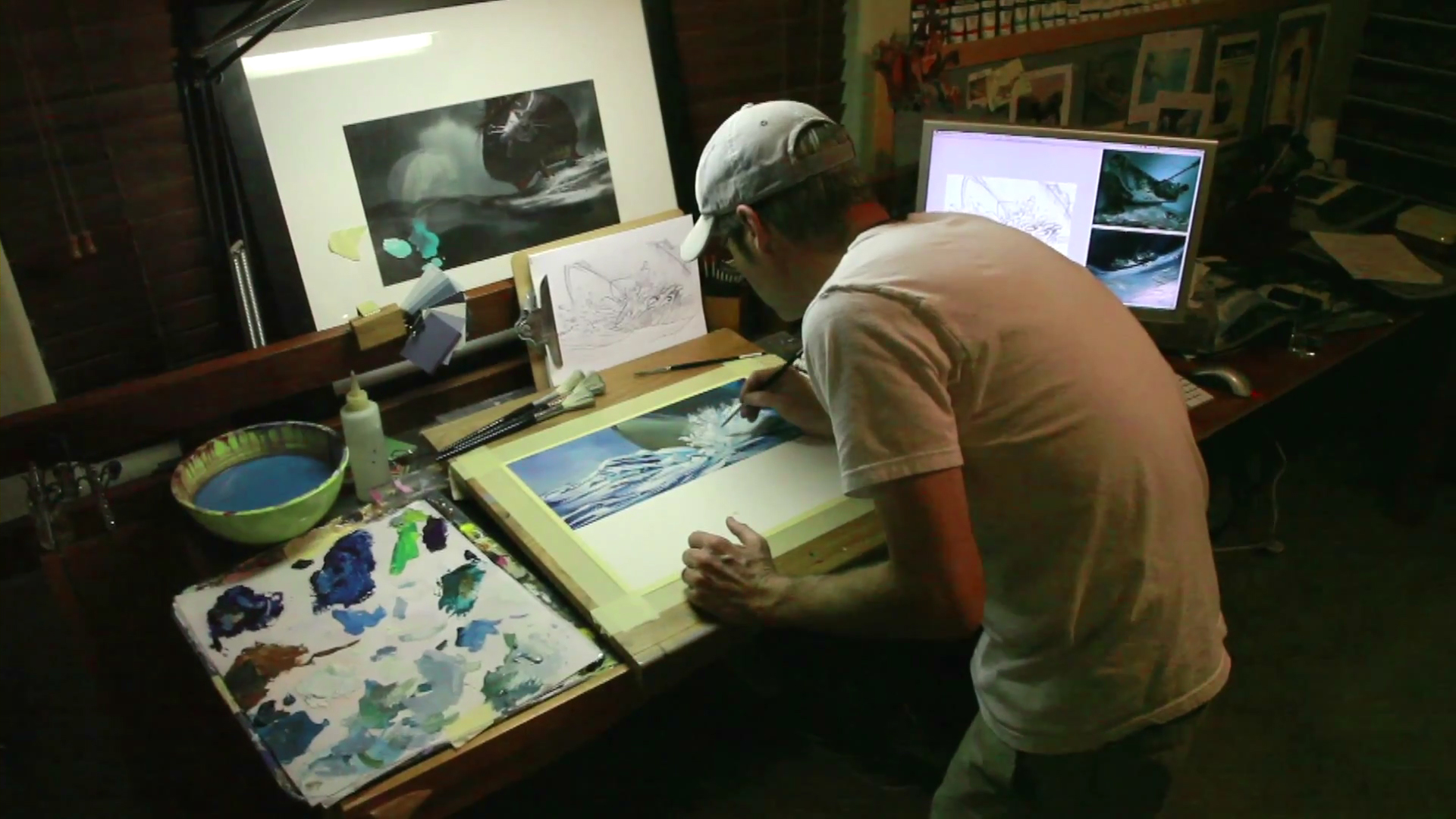You are here: Home > Information > Bibliography > How Roland Rolls
How Roland Rolls
Page 2 of 5

According to Carrey, "It’s a story about a wave named Roland who’s afraid that, one day, when he hits the beach, his life will be over. But when he gets deep, he’s struck by the notion that he’s not just a wave — he’s the whole big, wide ocean! It shows humanity’s interconnectedness through the metaphor of a wave in the ocean."
There’s a personal story behind the book...
"When I was a child," Carrey shares, "my parents were smokers and I had a deep fear that they would pass ... and then what would happen to me? I think that’s a common fear for children – the fear of loss. It’s an early existential crisis, if you will. But when we realize that beneath the surface of things – the activities of our lives -- we are all connected, all one energy, that fear of loss gets softened. At times, it disappears entirely. At least that’s been true for me." How did Roland the Wave emerge as a character for Carrey? "Years ago," he recalls, "when I first arrived in Los Angeles, I spent a lot of time on the beach in Malibu, watching the waves. I started to think of them as people, all moving in the same direction, and contemplated about where they go once they hit the beach and lose their form. Each wave travels all around the world. The first drop of water ever is still here now! That’s pretty profound stuff. I found that fascinating and comforting, and thought children could find that same comfort."

As a parent, and now a grandparent, Carrey reflects on the time he spent reading to his daughter, Jane. “I believe the closest we get to heaven in this world is when we get completely involved in something we love. One of those moments is when we read to our children. It’s total freedom from self, from our worries and problems. We always feel terrific afterwards, and so do the kids. For them, it’s an experience of focused, enveloping love."
Carrey believes that "everything we do that’s hurtful stems from a feeling of not being worthwhile, not feeling loved. Parents help their children feel worthwhile by being completely involved, spending moments together that are only about them. Through the loving attention of parents, children gain self-worth. Through the innocence of children, parents rediscover the wonders of life."
Why write a story for children? "First," Carrey notes, "I’ve always been drawn to work geared for children. That’s what attracted me to the Grinch, Horton Hears a Who, and Mr. Popper’s Penguins. Story is important to all of us. It’s how we order life the way we’d like it to be. Stories stimulate faith and hope."
"Through stories we make our children feel secure, and that good conquers evil. All the characters in a story are parts of ourselves, of course, so through stories we gain self-knowledge. We are inspired to embody heroic archetypes. We learn how to not let worries ruin our lives -- how to make that brave move into the unknown, then find that we’re usually pleasantly surprised by the outcome."

Just like Roland, Carrey had big dreams and goals as a child. At a very young age, he wrote poetry and even tried to get his poetry books published. "I learned pretty quickly that, in the publishing business, there was virtually no market for poetry written by an eight-year old. But, hey, I kept ‘rollin’!"
"I’m just telling a story," says Jim. "Kids don’t get credit for their deeper thoughts, beyond simple play ... for their efforts to figure out life. I hope Roland will help guide them along their way."
There’s a personal story behind the book...
"When I was a child," Carrey shares, "my parents were smokers and I had a deep fear that they would pass ... and then what would happen to me? I think that’s a common fear for children – the fear of loss. It’s an early existential crisis, if you will. But when we realize that beneath the surface of things – the activities of our lives -- we are all connected, all one energy, that fear of loss gets softened. At times, it disappears entirely. At least that’s been true for me." How did Roland the Wave emerge as a character for Carrey? "Years ago," he recalls, "when I first arrived in Los Angeles, I spent a lot of time on the beach in Malibu, watching the waves. I started to think of them as people, all moving in the same direction, and contemplated about where they go once they hit the beach and lose their form. Each wave travels all around the world. The first drop of water ever is still here now! That’s pretty profound stuff. I found that fascinating and comforting, and thought children could find that same comfort."

As a parent, and now a grandparent, Carrey reflects on the time he spent reading to his daughter, Jane. “I believe the closest we get to heaven in this world is when we get completely involved in something we love. One of those moments is when we read to our children. It’s total freedom from self, from our worries and problems. We always feel terrific afterwards, and so do the kids. For them, it’s an experience of focused, enveloping love."
Carrey believes that "everything we do that’s hurtful stems from a feeling of not being worthwhile, not feeling loved. Parents help their children feel worthwhile by being completely involved, spending moments together that are only about them. Through the loving attention of parents, children gain self-worth. Through the innocence of children, parents rediscover the wonders of life."
Why write a story for children? "First," Carrey notes, "I’ve always been drawn to work geared for children. That’s what attracted me to the Grinch, Horton Hears a Who, and Mr. Popper’s Penguins. Story is important to all of us. It’s how we order life the way we’d like it to be. Stories stimulate faith and hope."
"Through stories we make our children feel secure, and that good conquers evil. All the characters in a story are parts of ourselves, of course, so through stories we gain self-knowledge. We are inspired to embody heroic archetypes. We learn how to not let worries ruin our lives -- how to make that brave move into the unknown, then find that we’re usually pleasantly surprised by the outcome."

Just like Roland, Carrey had big dreams and goals as a child. At a very young age, he wrote poetry and even tried to get his poetry books published. "I learned pretty quickly that, in the publishing business, there was virtually no market for poetry written by an eight-year old. But, hey, I kept ‘rollin’!"
"I’m just telling a story," says Jim. "Kids don’t get credit for their deeper thoughts, beyond simple play ... for their efforts to figure out life. I hope Roland will help guide them along their way."
Hi, there! Jim Carrey here.
I know you recognize me from a whole raft of fairly wacky movies ... and quite a few pretty serious ones, too. But I'm reaching out to you and your children now for a serious purpose.
As a father and grandfather, I know there's nothing more important in our lives than the well-being and future success of our children and grandchildren. They are, in the most real sense, the future of our society. Indeed, the future of our global community.
When I contemplate their future success, I'm not just thinking about their financial prowess in the world though there¹s certainly a place for that. But rather, their success as human beings -- their ability to experience themselves as loved, loving, compassionate, empowered, and worthwhile. There¹s nothing more important than that. Indeed, it's the foundation for all the other successes in life ... the foundation for humanity's success in the world.
How do we help our young people experience that kind of personal success? I believe it's directly connected to the quality of engagement and involvement we have with them. So many children today are suffering from their parents' busy lives, how much time and energy it takes just to provide for the family and keep the household working. Often, the kids are relegated to electronic games, TV, and surfing the Internet — all poor substitutes for parental involvement.
I wrote How Roland Rolls specifically as a way for parents and grandparents to engage with children in quality together-time. Not only will the message of the story help them feel connected, worthwhile, and a part of something vast and grand ... the very act of you spending time simply to be with them, and only with them, will pay off in an experience of fulfillment that¹s truly beyond compare.
I wish you happy reading. And even more importantly... happy together time!

I know you recognize me from a whole raft of fairly wacky movies ... and quite a few pretty serious ones, too. But I'm reaching out to you and your children now for a serious purpose.
As a father and grandfather, I know there's nothing more important in our lives than the well-being and future success of our children and grandchildren. They are, in the most real sense, the future of our society. Indeed, the future of our global community.
When I contemplate their future success, I'm not just thinking about their financial prowess in the world though there¹s certainly a place for that. But rather, their success as human beings -- their ability to experience themselves as loved, loving, compassionate, empowered, and worthwhile. There¹s nothing more important than that. Indeed, it's the foundation for all the other successes in life ... the foundation for humanity's success in the world.
How do we help our young people experience that kind of personal success? I believe it's directly connected to the quality of engagement and involvement we have with them. So many children today are suffering from their parents' busy lives, how much time and energy it takes just to provide for the family and keep the household working. Often, the kids are relegated to electronic games, TV, and surfing the Internet — all poor substitutes for parental involvement.
I wrote How Roland Rolls specifically as a way for parents and grandparents to engage with children in quality together-time. Not only will the message of the story help them feel connected, worthwhile, and a part of something vast and grand ... the very act of you spending time simply to be with them, and only with them, will pay off in an experience of fulfillment that¹s truly beyond compare.
I wish you happy reading. And even more importantly... happy together time!

A significant part of the charm of How Roland Rolls is the book’s extraordinary illustrations. Award-winning illustrator and animator Rob Nason met Jim Carrey after Carrey had seen samples of his work (which he loved!) then flew him to Los Angeles.Rob Nason
“It was a day I’ll never forget,” says Nason, from his home in Scottsdale, Arizona. “Jim is a total class act, a gracious, down-to-earth human being, and a deeply interested and interesting man.”
The plan was to see how their personal chemistry felt, discuss the book and the possibility of working together. Soon after they began talking, they discovered that they were both from the same city in Canada – Burlington, Ontario – and the chemistry was underway. Burlington is Nason’s hometown, and Carrey lived there for about eight years.
Nason is not just an illustrator, but an award-winning animation artist and fine arts painter, as well, specializing in lake home scenes. He has deep childhood memories of living near a major lake, vacationing at a lake home his parents owned. “Life is about a body of water for me,” he admits. And How Roland Rolls is a story about a wave in the ocean. More chemistry!

With a deep appreciation for the classical art tradition, Nason uses all of the skills of his eclectic art background in his illustrations, making his work relatively unique and highly identifiable.
“I’m always trying to get a painterly look with a natural environment,” Nason says. To that end, when Nason is working on an illustration, he uses a water-filled airbrush in his left hand while painting with his right. “It helps create the reality of an atmosphere,” he says. Then he enhances the result digitally. It’s his special blend of technologies, woven from years of traditional painting, illustration and commercial art experience, plus, now, the wonders of the computer. “I don’t want to be just a digital painter,” Nason affirms. “I always want to incorporate my experience with the earlier art forms. Very few younger artists even know those mechanics.”
Nason’s art background is multi-dimensional and life-long. As he says, “I began my work on the inside of my diaper. It was lovely finger painting!”
Jumping forward about 17 years, after high school, Nason attended the George Brown College Centre for Arts and Design, a prestigious art school in Toronto. The school had a tradition in its three-year program –at the end of each year, the second and third year students would present a show of their work. Top prospective employers from around the country would attend, looking for the best new talent, and two or three of the students would get job offers. At the end of Rob’s second year, his work garnered the only job offer to come out of the entire show!
The dean of the school credited Nason with his third year studies (“You’re not going to learn anything more here!”) and sent him on his way, “You start your new job in two days!” Nason joined the art department at McLeod Young Weir, Ltd., a major financial services company in Toronto’s King/Bay financial district.
A year later, Nason was hired by Sullivan and Bluth, a leading U.S. film animation company, founded by former Walt Disney animator Don Bluth, to work in their Dublin, Ireland, office. Again, the instruction was, “You start next week!” There nearly five years, Nason painted backgrounds for their animated films, producing anywhere from five to 10 paintings a week. “Dublin is a great place,” Nason enthuses. “I must return!”
Nason moved back to Canada with his wife and Ireland-born son, continuing his animation work via courier, before the days of online file-sharing. Soon, Sullivan and Bluth moved to Phoenix, Arizona, becoming the animation unit for 20th Century Fox Film Corporation. The Nason family followed, moving to suburban Scottsdale. The film company set him up with a state of the art digital home animation studio, and Nason taught himself digital animation.
So, with his background in illustration and fine arts painting, he could now add the magic of the digital world, and his unique hybrid style was born.
Over the years, he worked on a variety of important animated feature films – Thumbelina, Anastasia, Pebble, Theo, Titan A.E. and many more. The crew won a Golden Reel award on Anstasia, as well as an Annie Awards nomination. His work on Thumbelina garnered the Hans Christian Andersen award. His cover for the best-selling children’s book, Saltwater Taffy, was nominated as Cover of the Year and was a finalist for the prestigious Benjamin Franklin award.
One of today’s most respected (and recognized) illustrators, Nason is ecstatic about his work with Carrey on How Roland Rolls. “It’s truly a co-creative process with Jim,” says Nason. “Jim really knows what he wants. He’s an extraordinary visionary and communicator, and a natural art director. It’s a joy to be working together.”
The plan was to see how their personal chemistry felt, discuss the book and the possibility of working together. Soon after they began talking, they discovered that they were both from the same city in Canada – Burlington, Ontario – and the chemistry was underway. Burlington is Nason’s hometown, and Carrey lived there for about eight years.
Nason is not just an illustrator, but an award-winning animation artist and fine arts painter, as well, specializing in lake home scenes. He has deep childhood memories of living near a major lake, vacationing at a lake home his parents owned. “Life is about a body of water for me,” he admits. And How Roland Rolls is a story about a wave in the ocean. More chemistry!

With a deep appreciation for the classical art tradition, Nason uses all of the skills of his eclectic art background in his illustrations, making his work relatively unique and highly identifiable.
“I’m always trying to get a painterly look with a natural environment,” Nason says. To that end, when Nason is working on an illustration, he uses a water-filled airbrush in his left hand while painting with his right. “It helps create the reality of an atmosphere,” he says. Then he enhances the result digitally. It’s his special blend of technologies, woven from years of traditional painting, illustration and commercial art experience, plus, now, the wonders of the computer. “I don’t want to be just a digital painter,” Nason affirms. “I always want to incorporate my experience with the earlier art forms. Very few younger artists even know those mechanics.”
Nason’s art background is multi-dimensional and life-long. As he says, “I began my work on the inside of my diaper. It was lovely finger painting!”
Jumping forward about 17 years, after high school, Nason attended the George Brown College Centre for Arts and Design, a prestigious art school in Toronto. The school had a tradition in its three-year program –at the end of each year, the second and third year students would present a show of their work. Top prospective employers from around the country would attend, looking for the best new talent, and two or three of the students would get job offers. At the end of Rob’s second year, his work garnered the only job offer to come out of the entire show!
The dean of the school credited Nason with his third year studies (“You’re not going to learn anything more here!”) and sent him on his way, “You start your new job in two days!” Nason joined the art department at McLeod Young Weir, Ltd., a major financial services company in Toronto’s King/Bay financial district.
A year later, Nason was hired by Sullivan and Bluth, a leading U.S. film animation company, founded by former Walt Disney animator Don Bluth, to work in their Dublin, Ireland, office. Again, the instruction was, “You start next week!” There nearly five years, Nason painted backgrounds for their animated films, producing anywhere from five to 10 paintings a week. “Dublin is a great place,” Nason enthuses. “I must return!”
Nason moved back to Canada with his wife and Ireland-born son, continuing his animation work via courier, before the days of online file-sharing. Soon, Sullivan and Bluth moved to Phoenix, Arizona, becoming the animation unit for 20th Century Fox Film Corporation. The Nason family followed, moving to suburban Scottsdale. The film company set him up with a state of the art digital home animation studio, and Nason taught himself digital animation.
So, with his background in illustration and fine arts painting, he could now add the magic of the digital world, and his unique hybrid style was born.
Over the years, he worked on a variety of important animated feature films – Thumbelina, Anastasia, Pebble, Theo, Titan A.E. and many more. The crew won a Golden Reel award on Anstasia, as well as an Annie Awards nomination. His work on Thumbelina garnered the Hans Christian Andersen award. His cover for the best-selling children’s book, Saltwater Taffy, was nominated as Cover of the Year and was a finalist for the prestigious Benjamin Franklin award.
One of today’s most respected (and recognized) illustrators, Nason is ecstatic about his work with Carrey on How Roland Rolls. “It’s truly a co-creative process with Jim,” says Nason. “Jim really knows what he wants. He’s an extraordinary visionary and communicator, and a natural art director. It’s a joy to be working together.”
« Previous | 1 | 2 | 3 | 4 | 5 | Next »










